|
|
Post by Deleted on Dec 8, 2016 1:31:25 GMT -5
codystarbuckI'm a fan of the Phantom and I also enjoyed the movie starring Billy Zane. I haven't seen the 2013 movie yet and I enjoyed the Comic Books that were published by Charlton Comics the ones that you've posted earlier. Those were very adventurous stories and they were excellent and your reviews brought back memories. 
|
|
|
|
Post by codystarbuck on Dec 8, 2016 1:54:40 GMT -5
My first exposure to the Phantom, that I recall, was in Popeye Meets the Man Who Hated Laughter, on the ABC Saturday Superstar Movie. That was a Saturday morning showcase for cartoon pilots. This particular one had various King Features comic strip characters (mainly Popeye) who have been shipwrecked by a guy who hates the laughter they bring. The adventure strip heroes are brought it, including the Phantom. Then I saw the Charlton comic, which was even cooler. Then I saw Don newton, which made it that much cooler. Then I saw Aparo's Phantom, and Boyette and the others and some of the comic strip. It's just a great concept. You can do period adventures and say it's an ancestor; you can do it in the future and say it's a descendent (like Phantom 2040). You can do almost anything with it and it works. He was Batman before Batman, with the cool cave and the scary presence (which Lee Falk remarked about, many times). The Zane movie is good; but, needed a better villain. I would have gone with Catherine Zeta Jones as the main baddie, experience or not. She had the presence. The Sci-Fi Channel pilot film? Meh. not awful; but, not great. It has some good elements, some bad. The costume attempt wasn't great. It was fine until you had the big armored collar and helmet. That killed it. The villain's scheme was a bit weak and a little too much like Silver Hawk, with Michelle Yeoh.
The movie serial is great, as Tom Tyler looks the part and there are some good cliffhangers. the story feels like a Phantom adventure. Tyler was a bit stiff, here and there; but, for a serial, it's pretty good.
|
|
|
|
Post by codystarbuck on Dec 8, 2016 16:05:43 GMT -5
Well, since "The Mystery of the Mali Ibex" seems such a hit, how about another Don Newton Phantom story?  Phantom #74 (final Charlton issue), "The Phantom of 1776" I've already talked about the cover; for my money it is the single greatest Phantom image of all time! Our story begins by recapping the history of the Phantom line and the world of Africa, in 1776: 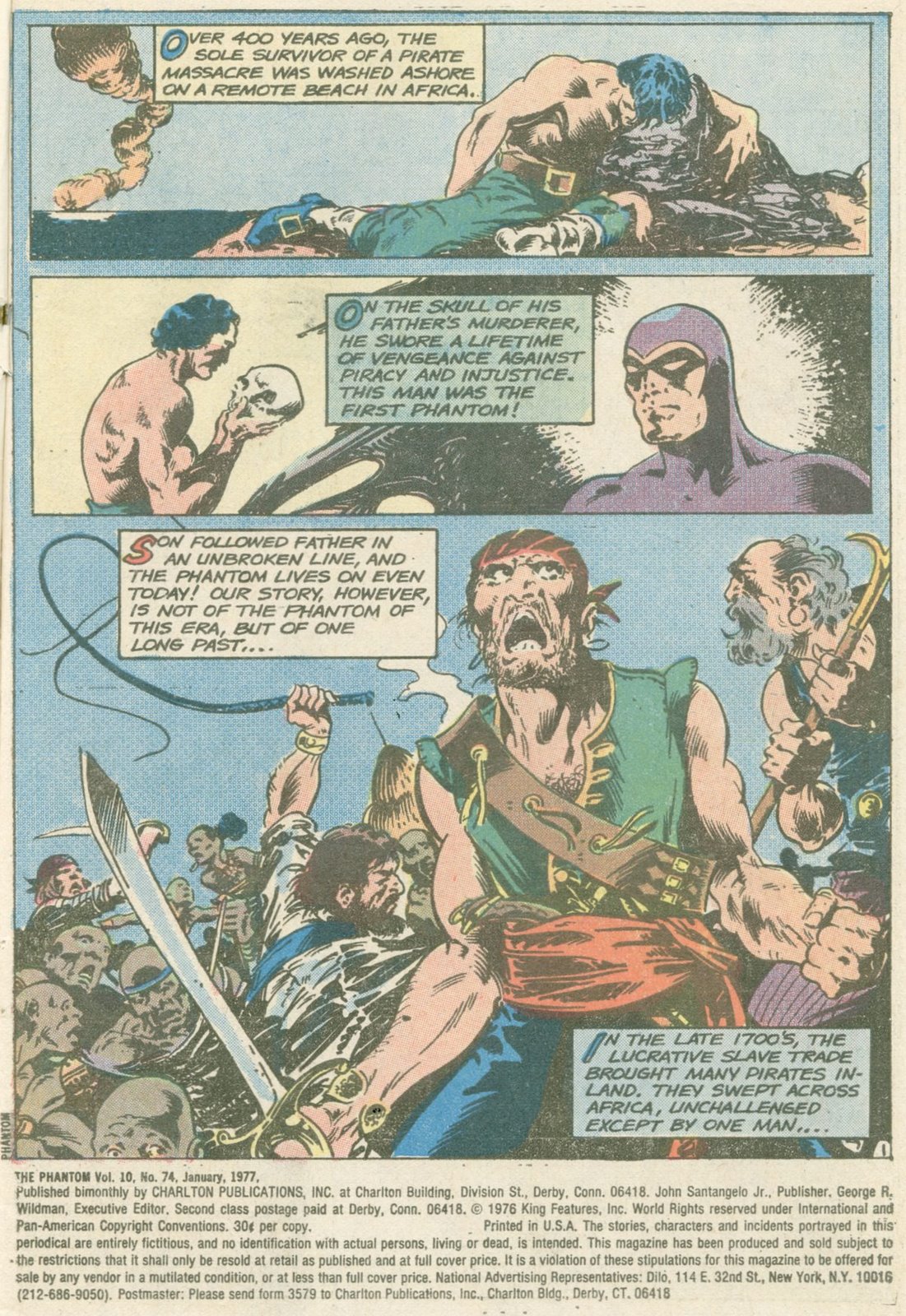 A runner comes and tells the Phantom that slavers have come to their village and taken the people, including the chief's son. The Phantom sees to the comfort of the man and races off to the village, where he finds the sick chief. He makes a vow to bring back the chief's son, before the rainy season. He is given a clue, the name of the pirate captain in charge of the slavers, Vruelle (Blasco Vruelle). he knows the name and heads for the Barbary coast, where he bluffs his way onboard a pirate ship, as Seaman Walker, newly released from a territorial prison. He sets sail with the pirates to meet up with Vruelle and prey on British ships in the waters of the New World. 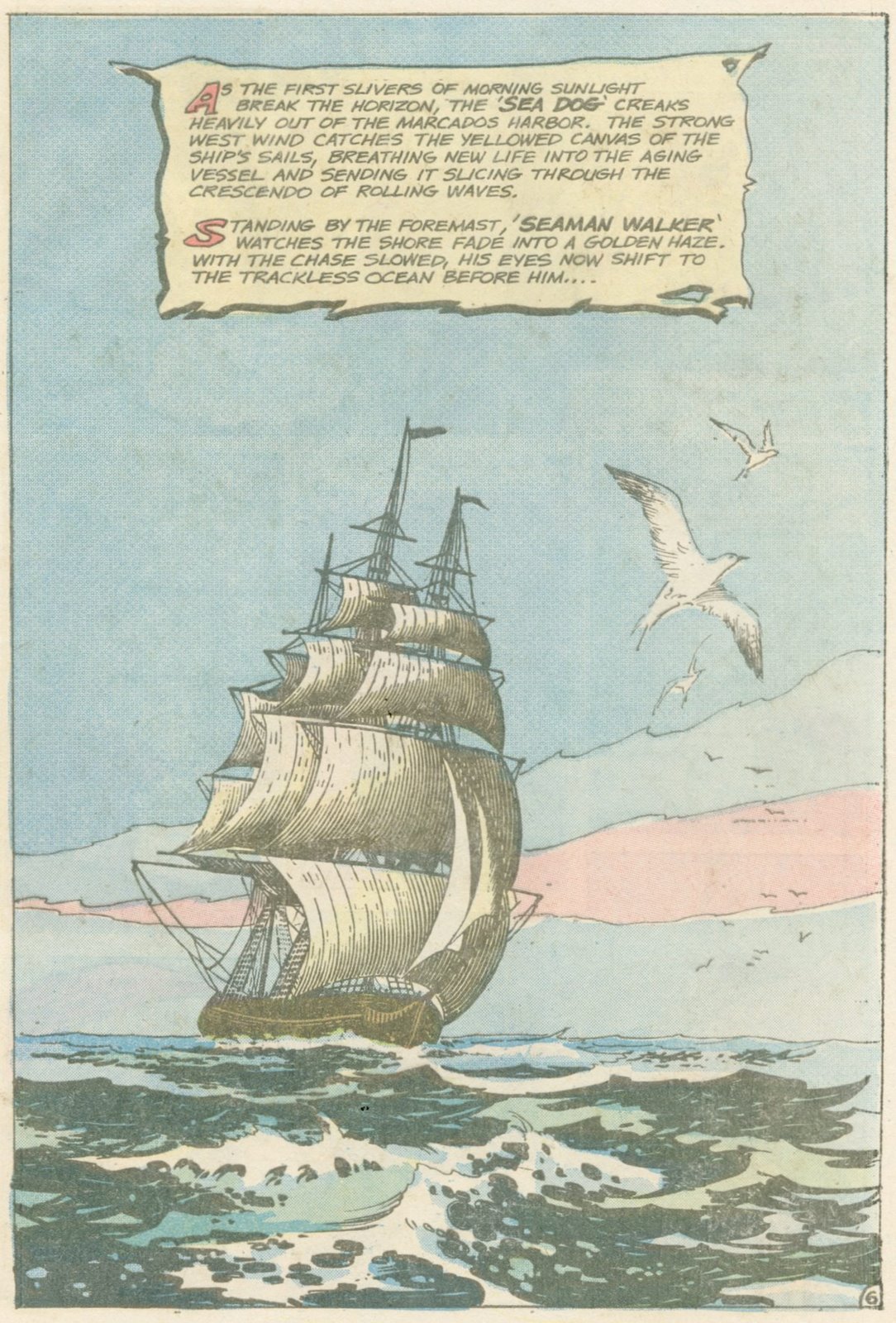 The ship comes to Virginia and the Phantom slips off to find Vruelle, eventually catching up to him and giving him an early alarm call. 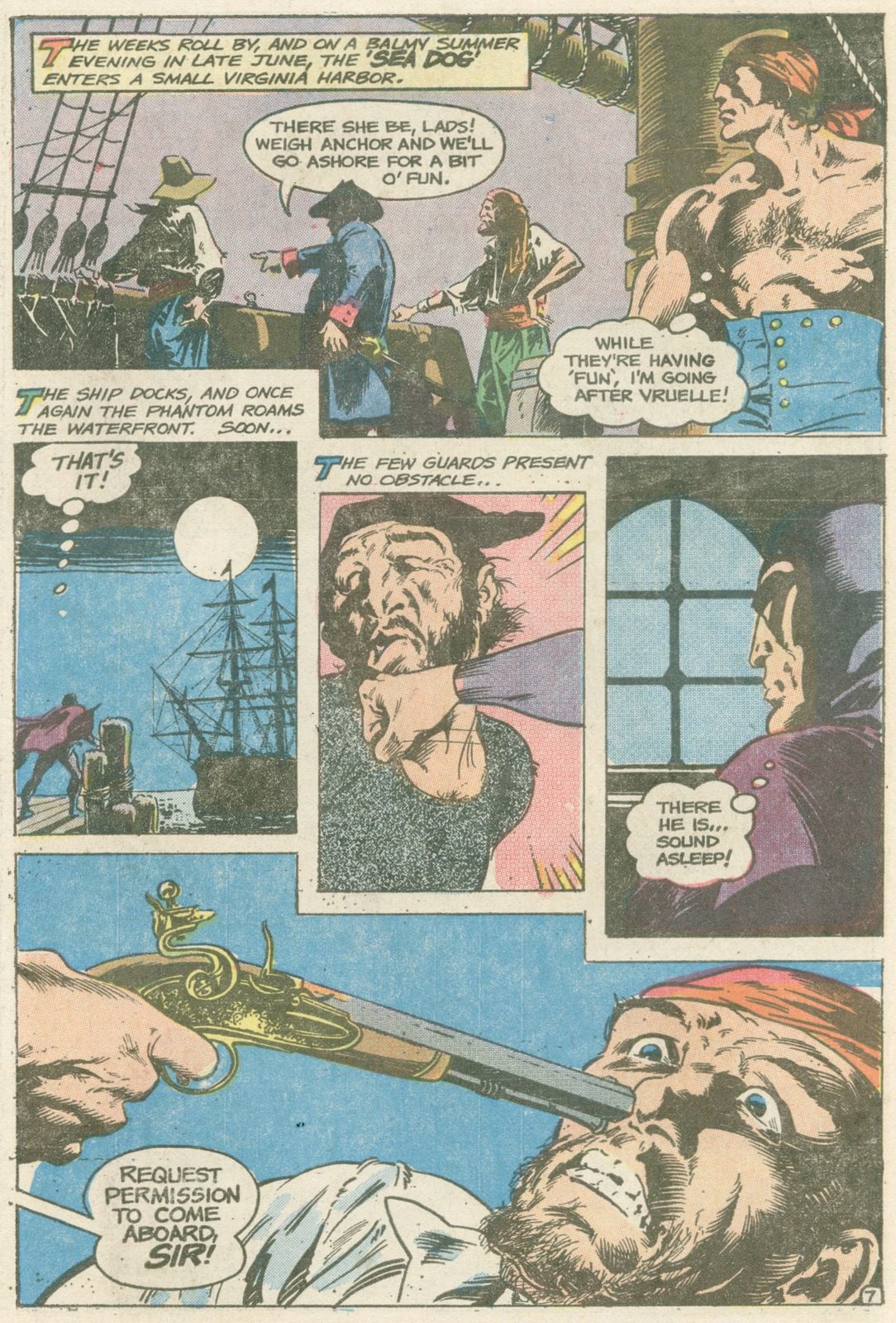 Vruelle has sold his slaves; but, the Phantom forces him to take him to the slave broker who purchased them. They find the man dead, at the hands of Captain Quench, the pirate who brought Walker across the sea. Pickens were slim, this voyage, as if someone was sabotaging the ship (give you three guesses...) and he remembered Vruelle's business with the slave broker. he figured he had a tidy sum lying around. Vruelle is able to trick Quench into turning his back to him and shoots him with a discarded flintlock pistol. The Phantom takes him down before he can fire the twin pistol. The pirate gets his hands on a cutlass, leaving the Phantom to defend with an andiron, from the fireplace. 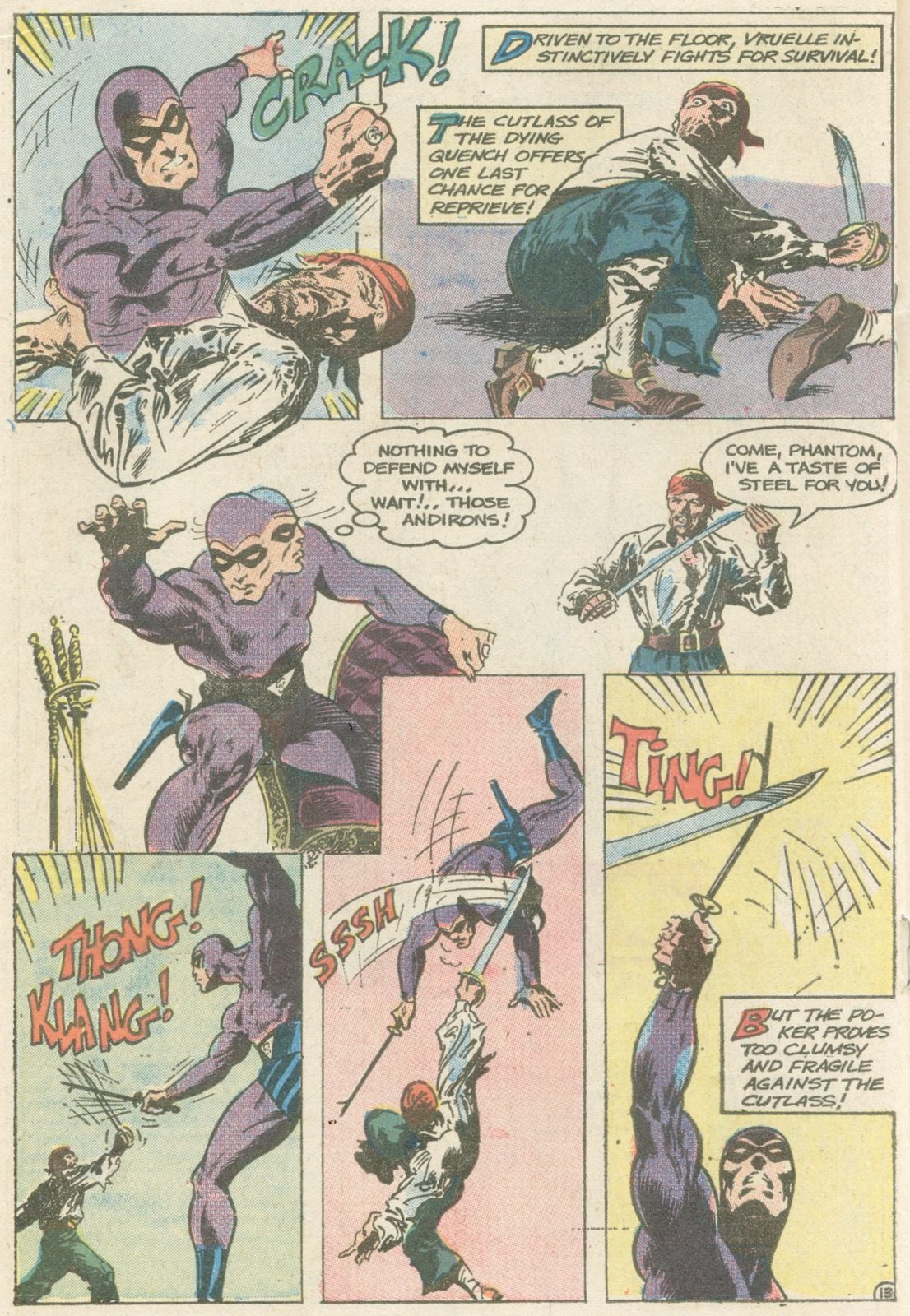 The dying Quench returns the favor, shooting Vruelle dead. The Phantom locates a bill of sale and tracks the chief's son to the Burgher Plantation. He finds it under siege by the Redcoats. Acting quickly, the Phantom uses his handy gunpowder keg to blow up sluices, which dam a nearby creek, for irrigation. It unleashes a flood torrent, forcing the British to retreat. Col. Burgher, owner of the plantation and leader of the rebels thanks the Phantom and asks how he can repay him. The Phantom tells the tale of the slave raid and Burgher lets the Phantom take the slave, after making it clear he treats his slaves well. The Phantom makes his way, with the chief's son to Philadelphia, where he asks the aid of Ben Franklin, who the phantom saved in Paris, previously. He asks help in locating and freeing the other slaves. Franklin agrees to book passage aboard a French ship, bound for Canada; but, cautions the Phantom against taking on a whole nation to free the rest. He tells the Phantom that a document is being signed which will change the world and, someday, put an end to slavery. 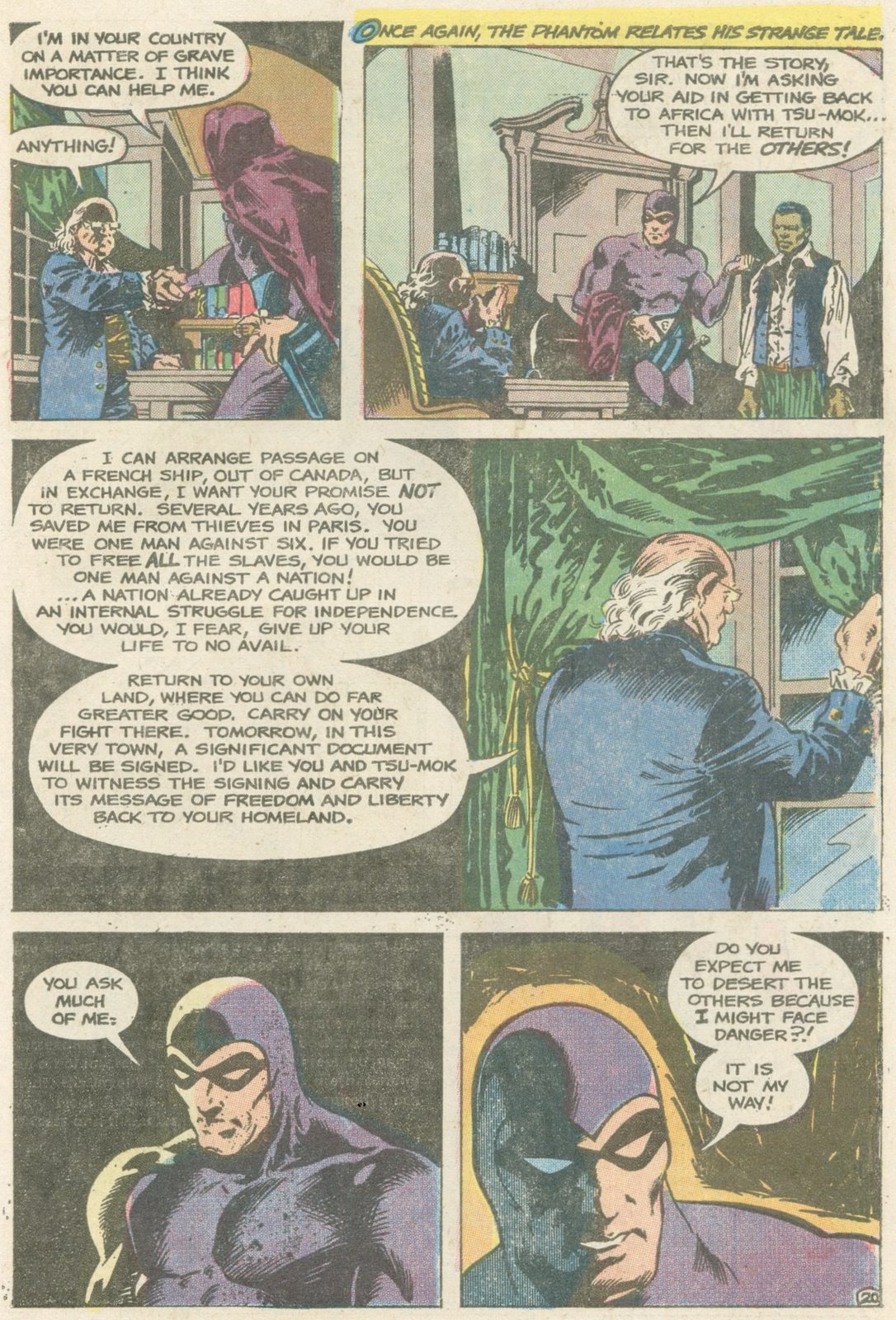 The Phantom and the chief's son witness the signing of the Declaration of Independence. 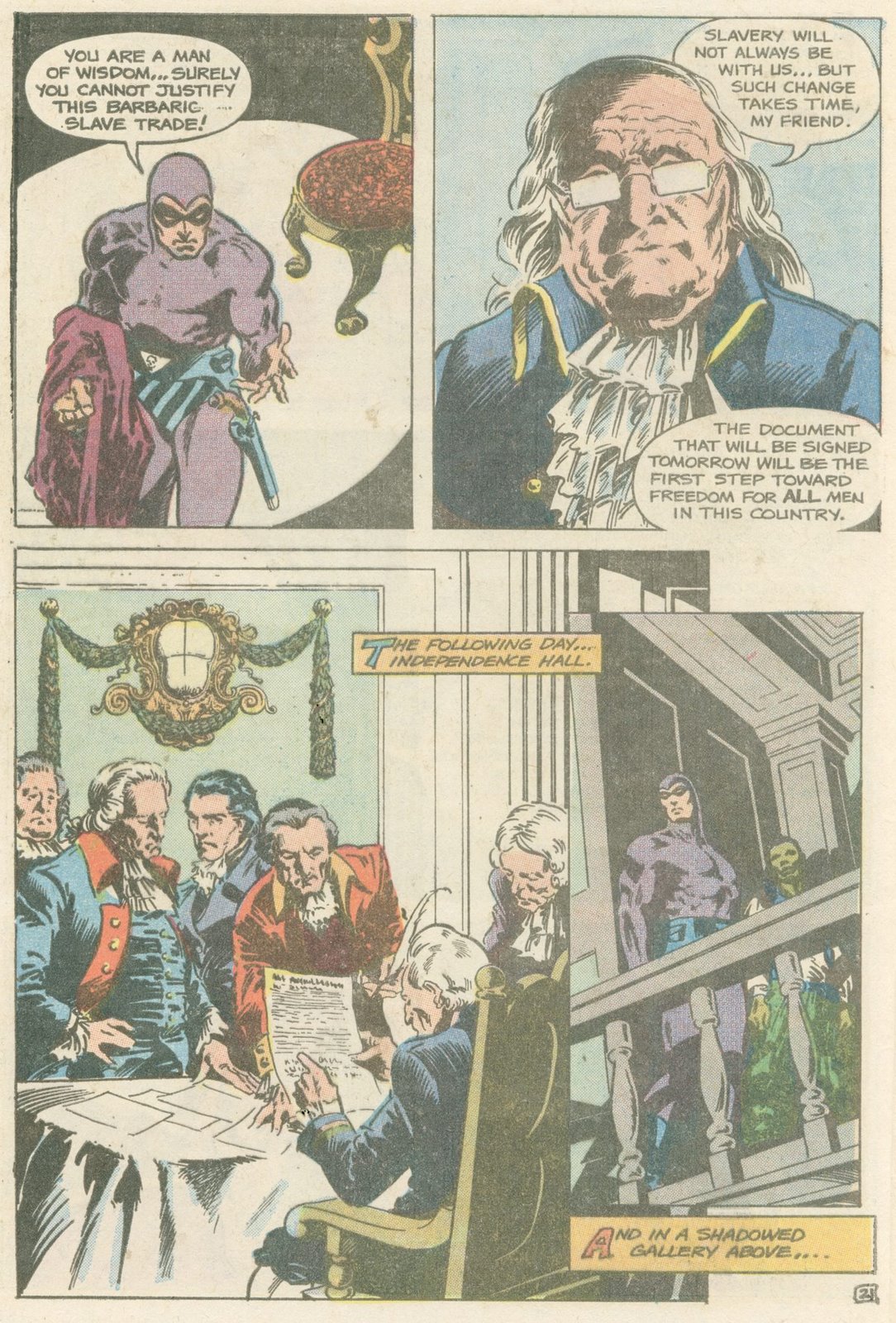 They make it back to Africa in time for the dying chief to see his son. The Phantom wonders about the people left behind and vows to never rest until slavery is ended. Newton ends the Charlton run of the Phantom with a bang. It's a nice mixture of a pirate tale, a Phantom adventure, and a bit of history, simplified though it may be. It also presents the prickly point of deifying the founding fathers, when slavery still existed. Even the men of the Enlightenment still cannot see all men as equals, regardless off skin color. It does set hope for the future, that this new nation will bring an end to slavery; but, it would take the bloodiest war in it's history to do it; and, even then take another hundred years to bring about the beginnings of equality, a struggle that continues. We have to remember that these stories were written for children and this issue does try to tackle a complex subject, even if it has to sugarcoat the solution. More politically minded writers, like Steve Engelhart might have made this into a bigger thing; but, Newton, who also wrote the story, understood that one man wasn't going to end slavery, hero or no hero. However, he ends it with the vow that the Phantom and his line would continue to fight to end slavery. It's too bad Newton didn't get to return to this, as I would have loved to see him have another Phantom aiding the Underground Railroad, perhaps helping Harriet Tubman. What can I say about the art that you can't see with your own eyes? Newton gets to do an old-fashioned pirate story and produces something that stands alongside Howard Pyle and NC Wyeth. He also knows how to stage the action, giving us exciting shots of the major action beats. He shows that you don't need splash pages to denote action, and that you don't need lots of lines; just the essential ones. He shows how you add mood, without using computer effects for color and shade. He's also done his research, getting the clothes, the ships, and the weapons right, without cliched cheats. Newton was an artist's artist, and was taken far too soon, by a heart attack. You can read the full story here: diversionsofthegroovykind.blogspot.com/2008/11/remembering-don-newton-and-phantom-of.htmlCheck down in the comments section, for a note from Tony and Christy Newton, Don's children. Meanwhile, if you want to see more of Newton's work, look here: www.donnewton.com/The site is filled with Newton's art, especially the rarer fanzine work. I would like to point your attention to one of those pieces, which appeared in The Golden Age #7, and was also reprinted in The Newton Portfolio:  I own this piece of art and it is amazing to look at. I bought it, via mail order, because it had the Black Terror, a favorite Golden Age character. Knowing it was Don Newton was a bonus. Seeing it was something else (there was just a description in the catalog, from which I purchased it). It is a real treasure. |
|
|
|
Post by Prince Hal on Dec 8, 2016 16:27:22 GMT -5
What a way for The Phantom to go out! Well done, codystarbuck, as usual. This and the Ibex story have always been favorites of mine. Make you wish Newton could have done the Phantom forever. |
|
|
|
Post by String on Dec 12, 2016 22:11:21 GMT -5
On the subject of Chaykin, I've never known of Starbuck (honestly I thought you just picked a cool name  ) But your review and the art are extremely compelling so may have track this work down. Some years ago, I saw Chaykin at HeroesCon in Charlotte. He appeared on a panel with Marv Wolfman, Roy Thomas, and one other whom sadly I cannot recall at the moment. Though I don't remember the specific topics of that day, I do remember that he had very strong and distinct opinions on the industry, medium, and fans. He spoke with fire and passion and while you may not agree with his opinions, I found him highly entertaining. Would love to see him again. On the subject of the Phantom, for me, Phantom is one of those characters, perhaps alongside Doc Savage, Shadow, Flash Gordon, that has seen so many interpretations and versions over the decades that it appears daunting for someone relatively new to them to find a spot to begin with. As such, I've read very little of the Phantom and again, your reviews are very compelling here. I'm mostly familiar with Newton's art through his DC work on Shazam, which I love and his work here on the Phantom is equally impressive. May have to track these stories down as well. |
|
|
|
Post by codystarbuck on Dec 13, 2016 2:46:07 GMT -5
On the subject of Chaykin, I've never known of Starbuck (honestly I thought you just picked a cool name  ) But your review and the art are extremely compelling so may have track this work down. Some years ago, I saw Chaykin at HeroesCon in Charlotte. He appeared on a panel with Marv Wolfman, Roy Thomas, and one other whom sadly I cannot recall at the moment. Though I don't remember the specific topics of that day, I do remember that he had very strong and distinct opinions on the industry, medium, and fans. He spoke with fire and passion and while you may not agree with his opinions, I found him highly entertaining. Would love to see him again. On the subject of the Phantom, for me, Phantom is one of those characters, perhaps alongside Doc Savage, Shadow, Flash Gordon, that has seen so many interpretations and versions over the decades that it appears daunting for someone relatively new to them to find a spot to begin with. As such, I've read very little of the Phantom and again, your reviews are very compelling here. I'm mostly familiar with Newton's art through his DC work on Shazam, which I love and his work here on the Phantom is equally impressive. May have to track these stories down as well. Newton is a great place to start with the Phantom. His first issue, #67 (at Charlton) features a retelling of the origin of the Phantom line and some notable members of the family, while the new Phantom takes his place. The plot is very similar to the first volume from the Avon paperback novel series, credited to Falk (many of the books were written by Ron Goulart, though nt that one), which was adapted from the comic strip adventures. You get several modern adventures, before they start looking at past Phantoms, as in 70 and 74. There's not a ton of continuity in the stories, which makes following along rather simple, apart from the relationship with Diana Palmer. In the strips (and the DC comic) they eventually marry. The Jim Aparo Phantoms are worth reading, though more for the art, as the stories are a bit generic. Aparo didn't do many, only about 7 stories and a few more covers. In general, the Charlton years were pretty good, with a nice mix of solid adventure stories. The Gold Key Phantom issues are also pretty good, especially with the George Wilson painted covers. Since it hasn't been reprinted, Cody Starbuck takes some tracking. I have all of the covers there. The Heavy Metal issues are probably the easiest to find. You can read the color special here: bronzeageofblogs.blogspot.com/2009/08/cody-starbuck.htmlThe first Cody story can be read here: theporporbooksblog.blogspot.com/2015_04_01_archive.htmlChaykin is just one of those really great experimenters with the form. He is a darn good storyteller, though his writing, in and of itself, can be confusing, at times. Some of his stuff is just kind of okay (more in recent years). When he was really pushing the boundaries, he was great. Now, he doesn't so much push boundaries as try to tell interesting stories. Crime fiction is his real love and his later work is infused with it. Chaykin from the mid-70s to the late 80s can't be beat. From the 90s onward, he had some interesting little projects (while working full time in Hollywood), most of which were overlooked in the hype and noise of the decade. I highly recommend American Century, which he did with David Tischman. An interesting through post-WW2 America, looking at the side usually hidden away in the Eisenhower years, though it filled the writing of men like Spillane, Cain, and Thompson, as well as the noir movies. You have to have a tolerance for cynical, in Chaykin's world, though his cynics are usually believers in the ideal; they just don't trust that it exists in the people in charge. Above all else, if you have never read Chaykin, read American Flagg. It s the culmination of his evolution as a storyteller and it captured the times so perfectly, while offering a vision of a future that has very much come to pass, in many ways. He is innovative for the first year of that book, then slowly pulls away from it. he came back to finish it up, then relaunch it with a handpicked team. That wasn't quite at the same level, though better than the others who touched the characters. I'll probably touch on some more Chaykin, here, though I would like to hit some other books first. Meanwhile, his generation of artists had some real outstanding talent: Jim Starlin, Walt Simonson, Mike Kaluta, Bernie Wrightson, P Craig Russell, Mike Grell and a couple of others of whom I am drawing a blank. Chaykin started as an assistant to Gil Kane, who was a man of very strong opinions, who also experimented with the form, in his career. After that role model, he fell in with Wally Wood, another opinionated guy, and Neal Adams (much the same). Howie was a bit more likely to come to blows than some of his contemporaries, back in the day, when he looked like this: 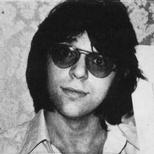 though he was still a ball of fire in the 80s. He's mellowed a bit these days, or just doesn't want the lawsuits. |
|
|
|
Post by Deleted on Dec 13, 2016 3:24:22 GMT -5
String codystarbuckWhile maybe not up to Aparo/Newton levels, a good place to start with The Phantom on the cheap to get a sense of the character and if you will like him is the 4 issue Phantom mini by Peter David and Joe Orlando from DC in 1988. There was a 13 issue regular series that followed, that's decent too, but a little different in tone form the mini. The David/Orlando mini gives you a sense of the history of the character, the types of stories told and is a fun rousing adventure in and of itself, plus it is dollar bin fodder so you can try it on the cheap before you plunk down money on the more expensive Charlton/GK issues.  Not to take a thing away form the issues codystarbuck recommended, they are awesome, but they are harder to find/a little pricier and if you are not sure you will like it, you might want a slightly more accessible/less pricey place to start. You could also go here and read the Phantom strips form 1996 to the present for free to try it if you were so inclined. -M
|
|
|
|
Post by codystarbuck on Dec 13, 2016 13:30:04 GMT -5
The sad thing is, that you could get that stuff pretty cheaply, for a long, long time. Then, people went nuts in the 90s and the internet changed the way things get priced. Suddenly, everyone was pricing mid-range comics like they are mint, if they were older than 10 or 15 years, whether there was a big market for them or not. You always had things shoot up in value when there was a new hot revival (like when Valiant was becoming big and people started looking for Turok and Dr Solar or the Valentino Guardians of the Galaxy). When I found my first comic shop, in college, in the mid-80s, I bought all of the Deathlok Astonishing Tales issues for an average of $.40. Those shot up when the character was revived, with the mini-series. That you expect. Now, I see all kinds of stuff that isn't related to a hot book, isn't scarce, and wasn't that big of a deal historically, selling for way more than I'd ever pay for it. That's collecting for you, though; the real market price is whatever you are willing to spend.
Charlton and Gold Key are a lot easier to find in mid-grade and lower, at more reasonable prices, if you do your homework. Hermes does have their reprint collections, though their print runs seem small and pricey. There are other methods out there, for reading the comics, if you are so inclined, particularly older stuff.
|
|
|
|
Post by String on Dec 13, 2016 17:50:10 GMT -5
Thanks for the suggestions all around.
I was looking around a few sites just to get an idea of the prices being offered for the Charlton issues and there is quite a range. eBay had some copies (all individual) from 8-10 bucks while a prominent site like Lone Star had F-VF copies from $15-21 bucks.
|
|
|
|
Post by codystarbuck on Dec 15, 2016 0:30:42 GMT -5
The Justice Machine          So, this time we delve into a bit more of an obscure series. Set your wayback machines to 1981. The Direct Market had opened up the doors to a plethora of small publishers and do-it-yourself creators. One of these was artist Mike Gustovich. I'm not fully up on his bio, as he was never a superstar; so, info isn't exactly plentiful. I believe he was from the Ohio or Michigan area, working in fandom circles and some small press. His first listed work is Cobalt Blue, in 1977, a superhero book. The book featured talent from the Ohio/Michigan area, including young William Messner-Loebs. In 1981, he launched his own series, The Justice Machine, with his own Noble Comics. This was in a magazine format, with the first issue featuring a cover by John Byrne, and art assist from several people, including Bill Loebs (as he was then known. Gustovich created the series, wrote it and pencilled and inked it (with assists). The basic concept is there is a parallel world to Earth, known as Georwell. This planet is ruled by an authoritarian government and the Justice Machine is it's elite counter-terrorist unit. They have been sent to take down a rebel enemy, the genius Maxinor. Maxinor has escaped Georwell, via a dimensional gate, to Earth. The Justice Machine have followed him and fought their way to them. However, a rival, Zarren, the chief prosecutor, has trapped them on this world, branding them as traitors. The team ends up opening their eyes to the corruption and oppression of Georwell and end up throwing their lot in with Maxinaor and a billionaire, Hammett Dash, who has his own little artificial island, Newhaven. The Justice Machine are now outlaws and soon find them facing a new version of the team (including Titan's brother, Monolith), but also assassins, genetic experiments and other threats. The idea was ambitious; maybe too ambitious. Gustovich was trying to mix superhero action with the fascist nightmare with Orwell's 1984. It created an interesting concept as a foundation. The team consisted of Challenger, the leader and weapons expert. He's the best soldier ever produced on Georwell. His wife is Diviner, who has telepathic and telekinetic powers, but is blind without her sensory cape. She hates Challenger for the death of their two sons, in a military adventure. There is Blazer, who turns out to be the daughter of Challenger, from an affair with another old Justice Machine member. Blazer can't control her flame power, without the help of her control suit, and is a prisoner of it. The giant of the team is Titan, who is an old comrade of Challenger and who has lived under the sadistic bullying of his older brother, Monolith. There is the criminal Talisman, who has karmic powers; when he does good deeds, he is filled with good luck. When he slips to crime, as is his wont, bad things happen. Then, there is Demon, the greatest had-to-hand combatant ever. He has lightning reflexes and speed, and can take down a squad in seconds. He's also addicted to a drug that enhances his abilities, in his quest to stay the best. So, you can see, these are complex characters. The Noble Comics experiment lasted 5 issues. The first finds the team chasing after Maxinor and ending up trapped on Earth and betrayed. The second finds them falling in with Maxinor and Hammett Dash, and squaring off against the Guardians, the new specialist team from Georwell.. In the third they fight an assassin, Blood Master. Issue 4 has them run up against the Freedom Force, a group of heroes from Earth. 5 sees them them battle a monster, who was the product of experiments by the Nazis, conducted by Dr Victor Von Croft, who is the head researcher for Newhaven. Von Croft has been sympathetic to the team and helpful, and must face his past. As you can see, there is a lot of promise; but, there were many problems. Gustovich was an inconsistent penciller and his strength lay in inking. As such, the art was very uneven. The printing on the issues wasn't the greatest, either. The magazine format proved to be a failure and was abandoned with the third issue, and the remaining two were done in standard comic book format. Then, there was low distribution and publicity. However, there was enough there to keep the spark alive. The Justice Machine got Gustovich enough notice to get him inking jobs at Marvel and then First Comics (inking Lenin Denisol on Starslayer). he was able to gain backing from an outfit called Texas Comics, to produce an annual, where the Justice Machine crossed over with the THUNDER Agents, in conjunction with Joe Carbanaro, who controlled the rights. The script was by Bill Loebs and featured art by Bill Reinhold, who had worked on the Noble series. It was inked by Jeff Dee and Brent Anderson. The story features a group of neo-Nazis, who have linked up with the Warlord and his terrorist organization, represented by Iron Maiden. A team fro Dash's strike force have infiltrated and try to get word back to Dash and Newhaven. Dash, sensing that this is big, tries to get in touch with THUNDER, but runs into red tape (in a rather comical scene). He dispatches the Justice Machine to get in contact. THUNDER is already on the case and the two teams collide and battle, before working things out and uniting to fight the Nazis. the story ends with a set-up for the next issue. However, a next issue was never to be produced. The annual is filled with action and some nice comedy, as well as suspense. The story is a bit muddled, with so many characters and Reinhold's art is a bit sketchy, at times. Like many small press books, it's a rough piece of work by inexperienced creators. It became better known for the back-up tale; the debut of the Elementals, from Bill Willingham (of Fables fame). That would factor into the lives of the Justice Machine again. So, we have two experiments that have ended in largely unsung failure. Well, not so much failure as indifference. At this point, the only notice the Justice Machine has had is a quick dismissal in Jeff Rovin's The Encyclopedia of Superheroes (a great reference book for superhero characters and costumed pulp heroes) and another curiosity, the Heroes Unlimited roleplaying game supplement: The Justice Machine Sourcebook. The Justice Machine Sourcebook, as well as heroes Unlimited, was the creation of Kevin Siembieda and his Palladium Games. Siembieda had done some inking on the Noble comics series, and worked with Gustovich to put together this sourcebook for his game. Heroes Unlimited was designed to be an open game system, which would allow characters from comic books and original sources to be used, under a set of rules. It was more notable for a Jim Steranko cover, plus images from Gustovich, Peter Laird (of the TMNT), and Siembieda (lots of robots). This sourcebook had a rundown of the characters, members of the Guardians, the Freedom Force, the characters from the Annual, and some generic characters and proved to be a nice reference for the Noble Comics series. But, it wouldn't be the end. Three years later, Comico picked up the rights to publish the Justice Machine and launched the mini-series The Justice Machine, featuring the Elementals. The mini-series finds the Elementals brought across the dimensional barrier to Georwell, where they are caught up in the intrigue of a being, known as Darkforce, who is actually an agent for another power. The Justice Machine, acting for the government, has taken down the rebel Darkforce, though not before an aid escapes. That aid is instrumental in bringing the Elementals to Georwell, and recruiting them to fight the repressive government. they believe they are fighting for freedom; but, they are being duped by evil demons from another dimension. Meanwhile, the Justice Machine believe they support the rightful authority on the planet. They are sent to stop these new beings and capture them. However, they discover that darkforce is free and has opened the dimensional gate, to allow the shadow demons access to Georwell. the Justice Machine must work together with the Elementals to defeat the demons. They do so when the demons turn on Darkforce, who is using all side against each other for his own power. he is taken down by the combined forces and revealed to be a little girl with powerful psychic abilities, who is the daughter of Darkforce's aid. The Darkforce armor is just a hollow shell manipulated telekinetically by the girl. She will face trial, while the Elementals are allowed to return home. however, their presence has altered how the Justice Machine views its government. They had sown the seeds of doubt. The mini-series was excellent, featuring a story by Willingham and art by Gustovich. It is filled with intrigue and complex characters, and plenty of action. It came when Comico tried to distribute via newsstands, as well as the direct market. This experiment ultimately failed and put Comico into financial peril, which led to bankruptcy. However, the mini-series was a success and a series would follow. The series, like the mini-series, dispensed with the old continuity. Some of the characters, like Demon, got a bit of visual reworking, while the basic personality traits and weaknesses remain. The series picks up with the mission to take down the rebel Maxinor and parallels the Noble series, with the team duped by Zarran, who thinks they have been tainted by contact with the Elementals. Maxinor opens their eyes further, as does a battle with the new Justice Machine, sent by Zarran. They fall in with Maxinor and eccentric billionaire Donald Hamilton, who has created the artificial island, New Atlantis. This new series featured outstanding writing from marvel and DC veteran Tony Isabella (Ghost Rider, The Shadow War of Hawkman, and Black Lightning) and art by Gustovich. The series finds them at odds with Georwell, as well as discovering secrets on New Atlantis. Demon's drug addiction eventually gets out of control, making him psychotic and he appears to die. We explore a bit of the past of the team, in a couple of episodes. The series culminates in an attempt toby Georwell to conquer the Earth, which the combined forces of the Justice Machine and the Freedom Force defeat. A new path was established, when the series came to an end. The Comico series is the one to read, as it has the best and most fully realized stories. Isabella does a tremendous job with these complex characters and adds some professional experience to the book. He eventually leaves the book and that is when it starts to falter. The series is still plagued by Gustovich's inconsistent art; but, it is much improved over the Noble series. That seemed to be the end; but, never count this team out. It gained new life at Dave Campitti's Innovation Comics, where it crossed over with the Hero Alliance (another refugee from a failed company) and started a new series, with the team in new circumstances. it kind of floundered, introducing new costumes, including a horrible one for Demon, whose previous swashbuckling look well suited the character. Tony Isabella came back to write, which helped. However, innovation also ran into financial problems (the ongoing story of the late 80s). The team survived and ended up at Millennium. The Millennium series was done by the same team as Innovation, Mark Ellis and Daryll banks. Gustovich sold the series to Ellis, and had nothing to do with the Millennium issues, and little to do with the Innovation stuff, as he had more work at Marvel. There were only two issues at Millennium, before they ceased publishing it. Ellis later put out a trade collection and then an original graphic novel in 2014. The magazine size first three issues of the Noble Comics series run for around $15, mint, but the final two can be had for under $10. Lower grades should net more affordable prices. They are an interesting read, filled with potential, though light on execution, and flawed by poor production. For my money, the second issue was the best of the lot, in terms of story and action, while the final issue had the best writing. The Texas Comics Annual can be had for under $10 and is worth the read, even moreso by introducing the Elementals. it's got plenty of action and quite a bit of fun, and brims with enthusiasm. It's not that hard to find, compared to the Noble issues. The ones you want, though, are the Justice Machine/Elementals mini-series and the Isabella issues of the regular series. Most can be had for $5 or less, with only a few issues hitting double digits, mint. The Innovation stuff is even cheaper, as is the Millennium material. The Heroes Unlimited Justice Machine Sourcebook is the most expensive of any Justice Machine book. If you like your superheroes with a bit more depth, give this series a try, especially the Comico issues. It's far from perfect, and not at DC or Marvel standards; but, it has an independent quality that those companies don't bring to their books. It's like a really good local band, who excels at live shows, whose studio album doesn't quite convey the experience of seeing them live. it can't match the big label bands, on CD; but, it can jam with them on stage and hold its own. Apparently, I'm not the only fan, as in researching this, I discovered that the upcoming issue of Back Issue, from Twomorrows, has a history of the Justice Machine. So if you are curious for more, check out that issue, on sale in February. |
|
|
|
Post by codystarbuck on Dec 16, 2016 3:59:51 GMT -5
The Scorpion    Who's up for some more Chaykin? Waaaaaaay back in 1974 (Kirby, I'm old!), Martin Goodman decided to get back into comics, after selling Marvel to cadence Industries. The story goes that part of his motivation was that son Chip was passed over as president. Father Martin wasn't exactly kind to son Chip, according to many accounts, so you have to wonder how much fatherly pride entered into it. Whatever the case, he decided to challenge Marvel head on, in the fine honored Goodman tradition; rip them off and glut the market with knock-offs. And he did. he hired Jeff Rovin, a young editor for Warren, and Stan's little brother, Larry Lieber, to edit, then offered buckets of money to attract talent from elsewhere. You can read more about the history at The Atlas Archives: www.atlasarchives.com/Howard Chaykin was one of the guys who took the money and he was also the one to offer up one of the more original ideas (though not wholly original, as we will see), in The Scorpion, a pulp hero, in the style of The Shadow and The Spider. Rovin had actually pursued comic book rights to the Shadow and Spider; but, found them too expensive for Martin Goodman's taste. So they created their own. Chaykin was an old fan of the pulps and crime fiction, so it was right up his alley. he gave us Moro Frost, adventurer and hero. First up, check out the cover. We have our hero front and center, looking suitably swashbuckly, with his vest, aviator's goggles and scarf, riding boots, and high-waisted breeches; not to mention, pistols slung in crossdraw-fashion, on his hips. We see our damsel in distress, tied to the prop of an airplane engine, which would rip her arms from the sockets if the engine is started. We see off-page menacers, with pistols pointed at our hero. All suitably pulpy, in the finest traditions of the genre. Chaykin introduces us to the mysterious history of Moro Frost... 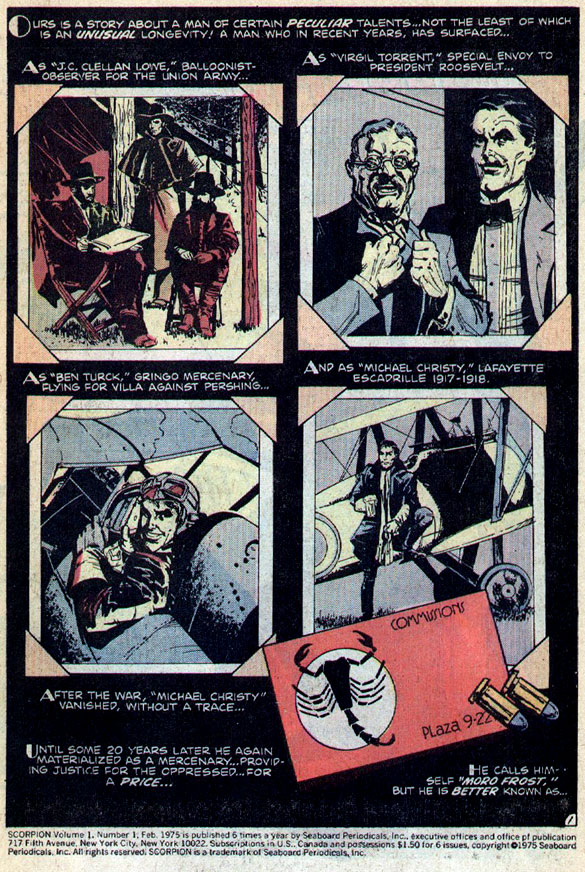 So, our hero can be traced back to the Civil War, some 70 years before our story. he has assumed and discarded identities along the way. Is he immortal or just long-lived? Sounds a bit like Connor McLeod, in Highlander, some ten+ years later. Chaykin wastes no time in getting things going, hitting us with a nice two-page spread, featuring our hero and some dame... 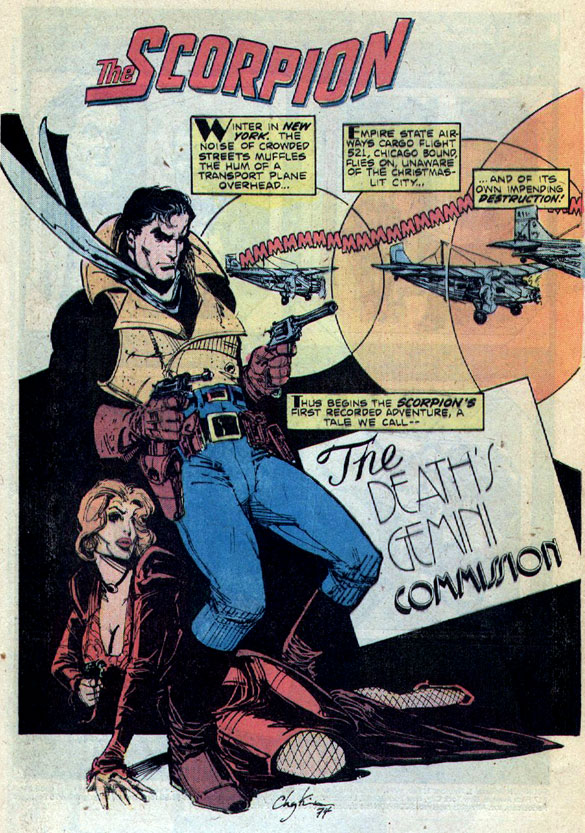 We see a plane start sputtering and then plummet from the sky. our hero and his girl witness it and notice it is heading for near their house. They race over and find the crash site, with the pilots dead at the controls, wearing parachutes. Curiouser and curiouser. Our hero runs into Roger Boyle, head of Empire State Airways, whose company is being sabotaged, with this being the 4th plane lost. he hires The Scorpion to investigate it and put a halt to the calamity. We cut to upstate New York, where a transport tycoon is consulting with some shady characters, who have landed in a seaplane. The plane is equipped with an amazing device which focuses sound into a weapon and used it to cripple the earlier plane. The thugs got the weapon from an inventor, who met with an accident. A few days later, The Scorpion takes off in a Boeing P-26 Peashooter fighter plane... 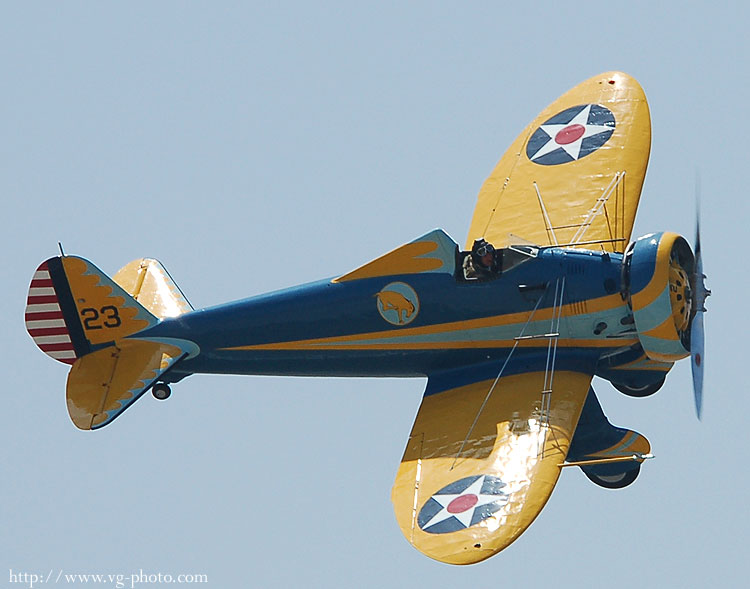 ...to shadow the latest ESA flight. He spots the hoods' plane and swoops down and shoots it out of the sky. We cut to Miss bishop, The Scorpion's girlfriend/secretary/assistant. She's been hanging out in the dockside bars, looking for clues to the identity of the saboteurs. Sh e is accosted near one, by men who observed her eavesdropping. They attack and she takes out two with some pretty deft fisticuffs, then, holding them at gunpoint. A third disarms her aand she is menaced, when The Scorpion shows up and punches a confession out of the men. We cut to the rival magnate's office, where our air pirates show up, having parachuted to safety. They want their money and the tycoon seems to oblige and pulls a gun, and gets shot dead, for his trouble. The hoods find plans to an aircraft carrier, which they say they can sell to the German consulate. We cut to Moro Frost's house, where Miss Bishop answers the phone. It is Boyle, who needs to see her. She was stepping into a bath (which is why Chaykin gives us a shot of her in a towel); but she will meet up with him. Well, it turns out the thugs have him at gunpoint. They take Miss Bishop for a ride. Moro gets a call telling him to meet Boyle at the airfield, so he heads out; and, runs right into the hoods, who have recreated the cover. They have a timer set-up that will start the engine. They force The Scorpion to drop his gun, then attack with an axe. he whips off his deerskin vest and uses it as a weapon, since it is lined with chainmail!. he takes out one thug and the other hightails it out. He gets to the engine as it starts to sputter, stopping it in the nick of time. he takes off after the other thug, on a motorcycle. the hood has a plane and is taking off. The Scorpion hits the back end of a car and launches the bike in the air, where he lets loose with his pistol... 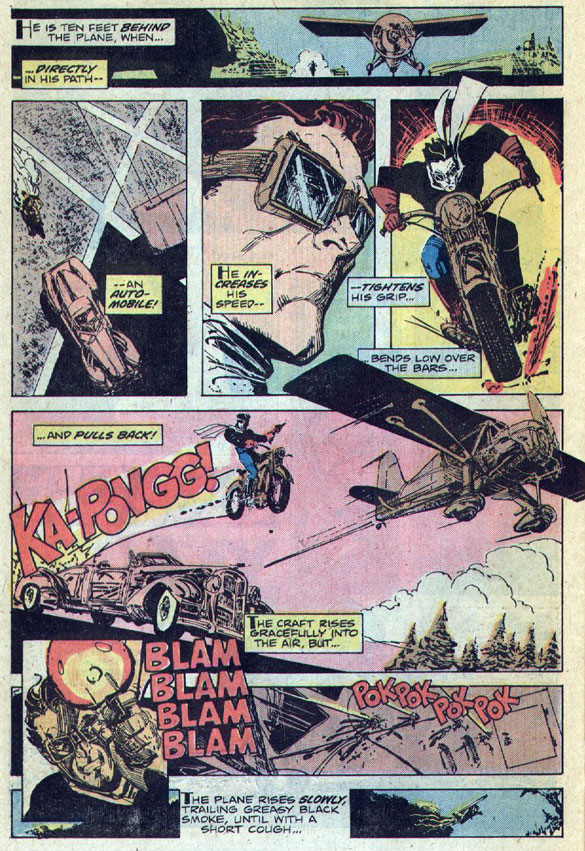 Chaykin launches the series with a bang. As with Cody Starbuck, he is both writing and drawing. He captures the period well and keeps up the mystery and action. What he doesn't really do, though, is develop the characters. All we know about Moro frost is that he lives well, is fairly old, and works for high commissions. Miss Bishop is even more of a cypher, a pretty woman, Frost's lover, and a tough character in her own right. There's a foundation; but, we have a ways to go. Issue 2 features a new case and a cover by Ernie Colon. Chaykin did a cover; but, it wasn't used: 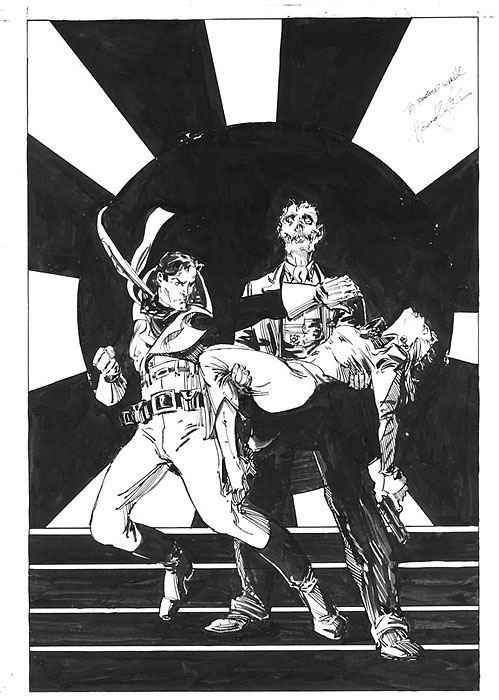 Moro and Miss Bishop are in a nightclub, discussing a potential new client, who is afraid for his life. He is being menaced by voodo and black magic. moro dismisses taking the case, when he is told he has a phone call from the distressed man's wife. As he goes to take the call, he is attacked by a lion. Moro reacts by pulling a knife from his sleeve and kills the lion, which turns into a naked man. He decides to take the case. he meets with the wife and learns that her husband grabbed some documents and ran off, muttering something about a gangster, named Cervantes (hopefully not related to Don Quixote's creator), who is believed dead. The Scorpion investigates and uncovers clues that point to Cervantes being alive. He tracks him down to an old haunt and finds that the missing man was also Cervantes, who faked his death and had plastic surgery. He told an aid about voodo witchdoctors and grabbed some bankbooks and then hid behind a secret door. The Scorpion finds him dead, with a voodoo doll at his side. We learn about a pair of Harlem gangsters, who killed Cervantes and stole the bankbooks, but need the wife to sign for the money, in Panama, where the bank resides. They have the services of a hoodoo woman, who they kill, as having served her purpose. The Scorpion alerts the wife that she is in danger and gives her a gun. he then tracks down the Harlem Hoods, but finds the dying hoodoo woman, who tells them where they have gone. meanwhile, Miss Bishop learns that Cervantes body has disappeared. Miss Bishop heads off to investigate and is nabbed by hoods, who think she is the wife. they bring her to the Manhattan Skyport, where their plane is waiting. The Scorpion shows up, thanks to the tip from the dying woman and attacks. he kills one of the gangsters and the other grabs Miss Bishop. She frees herself and he runs off, running into his cat, who transforms into a lion and kills him, thanks to a hex from the hoodoo woman. She had mentioned a second hex, which is the animated corpse of Cervantes, who shows up to find his wife. The Scorpion gets back in time and blows up the corpes, saving the widow. The art is more uneven here, as Chaykin is inked by Bernie Wrightson, Mike Kaluta, Walt Simonson and Ed Davis. It seems that Atlas gave him a tight schedule and he had to scramble to get the book done. As such, the quality of the line work varies heavily. It also results in the story seeming rather rushed. Look at this panel 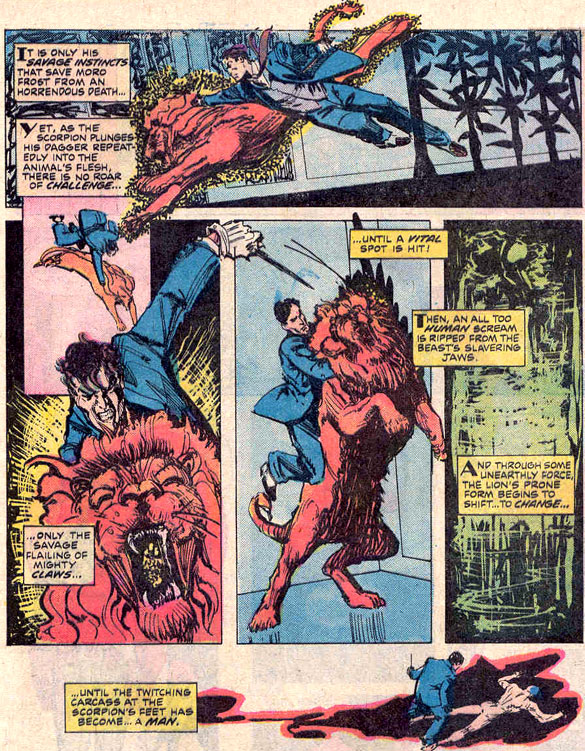 and compare to this one 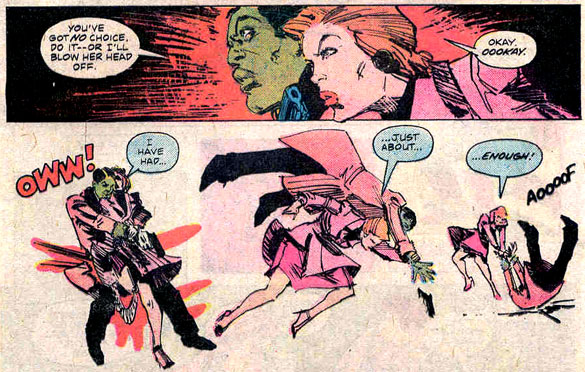 Not quite the same consistency. It probably would have been better had Chayin inked himself, as he did on the first issue. This is still early Chaykin, and his line is still on the sketchier side, not having come under the influence of Toth, yet. He's got a flair for the material; but, needed more time to make it look and sound good. It was also his last issue. Atlas became notorious for revamping their books after 2 or 3 issues, as their low sales (due to poor distribution, as much as anything, along with a shaky market) prompted Goodman to demand that the titles be "Marvelized." Many creators bolted, tiring of interference and some questionable promises. Chaykin walked and went back to Marvel, where he had a meeting, without an idea; but, then started a stream-of-consciousness pitch of a variation on the Scorpion. Where that character inhabited Manhattan, this one would live off the coast of LA, on a gambling ship, outside the 3-mile limit. the boat is owned by his love interest, to whom he also owes a lot of money, due to gambling losses. He takes contracts to pay the rent. The character was...  Chaykin evolved his idea into a much better character, aided greatly by the writing of Denny O'Neil. Fortune had two stories in the black & white Marvel Magazies (Marvel Preview #2 and Marvel Super Action #1) a third color issue in Marvel premiere, then turned up in Hulk Magazine, in a series of stories with Chaykin's painted art. The Scorpion wasn't done though. He was turned into a Daredevil ripp off, with a new identity, (Moro frost believed killed in WW2, though no body is found). He takes on a Nazi goon, called the Golden Fuhrer. The story is by Gabe Levy and art by Jim Craig. The Scorpion is now newspaperman David Harper. The villain is a rip-off of the Red Skull, adding to the misery. His stormtroopers attack a rabbi, who later brings a golem to life. It's all pretty derivative and not worth tracking down, unless you like oddities or are a completist. Chaykin does a pretty good job with The Scorpion and it was one of Atlas' best books. However, the schedule was too tight and it affected his second issue. Chaykin is still young, as an artist and though he has a flair for the material, he doesn't quite have the chops yet to make it a classic. it is more of a beta test for the much more developed Dominic Fortune. If you like pulp adventure, it's worth hunting down those two issues. Aside from the much rarer black & white magazines that Alas put out, they are the most collectible of the Atlas/Seaboard books. At mint prices, they would set you back around $25. Funny enough, the third issue commands higher prices, since it had a lower print run; but, the material doesn't justify the price. As for Chaykin's character, there is a really interesting idea there, especially the mystery about Moro Frost's age and whether he is immortal (or very long-lived). Despite the talk of ownership, the indicia of the comic claims Seaboard Periodicals (the official name of the company) owned all rights. Since the comic continued without Chaykin, I don't think he owns any part of it. A few years ago, Jason Goodman, Martin's grandson attempted a revival. It didn't last particularly long. It featured a revival of Wulf the Barbarian, The Grim Ghost and The Phoenix. |
|
|
|
Post by mikelmidnight on Dec 16, 2016 12:28:03 GMT -5
I was a fan of the Atlas/Seaboard line for some time, and had about 80% of their color comics. They're all long gone, though I still have issues of The Scorpion.
|
|
|
|
Post by codystarbuck on Dec 16, 2016 13:19:45 GMT -5
I too, collected the Atlas/Seaboard line and had just about all of the color line, except Vicki (their Archie rip-off). Never even saw one of those. I never came across any of the b&w magazines. I have a digital colelction, now, which includes all of the material. The magazines were shameless rip-offs of Warren, including a monster magazine that desperately tries to be Famous Monsters of Filmland. There's some decent comics in there and I will highlight a few more hear, in the near future.
|
|
|
|
Post by EdoBosnar on Dec 16, 2016 17:25:03 GMT -5
Great series of posts, especially these last few: love Chaykin, and I had a really fondness for the Justice Machine - the original Noble series, of which I had a few issues (and I loved the Cobalt Blue features as well). You're really hitting me where I live.
Anyway, I was just a bit too young for Atlas/Seaboard when they were on the spinner racks; I recall seeing a few of their titles back when I just started reading comics, but I never got any of them. However, as a fan of pretty much all things Chaykin, I made it a point to track down the two first issues of Scorpion a few years ago. I really like them quite a bit, even that second one with all of the art assists. You're right, the characters are pretty simplistic, but the stories really capture the feel of the 1930s pulps. And that art - yes, Chaykin was still learning his craft at this point, but like you said, the flair and style are already there.
Great posts, looking forward to future installments.
|
|
|
|
Post by codystarbuck on Dec 18, 2016 3:07:00 GMT -5
Why don't we stick with Atlas/Seaboard for a little bit? This time. The DESTRUCTOR!!!!!     The Destructor comes to us courtesy of Steve Ditko, with Archie Goodwin script for 3 issues, and Gerry Conway on the 4th, where it got the inevitable Atlas revamp. The first two issue are really worth tracking down, if only for this line-up: Script by Archie Goodwin, Pencils by Steve Ditko, inks by wally Wood. That's a hell of a combo, and it delivers, in spades! It's basically the Spider-Man template (keeping up the Atlas philosophy of why develop when you can steal), with a bit of interesting tweaking. 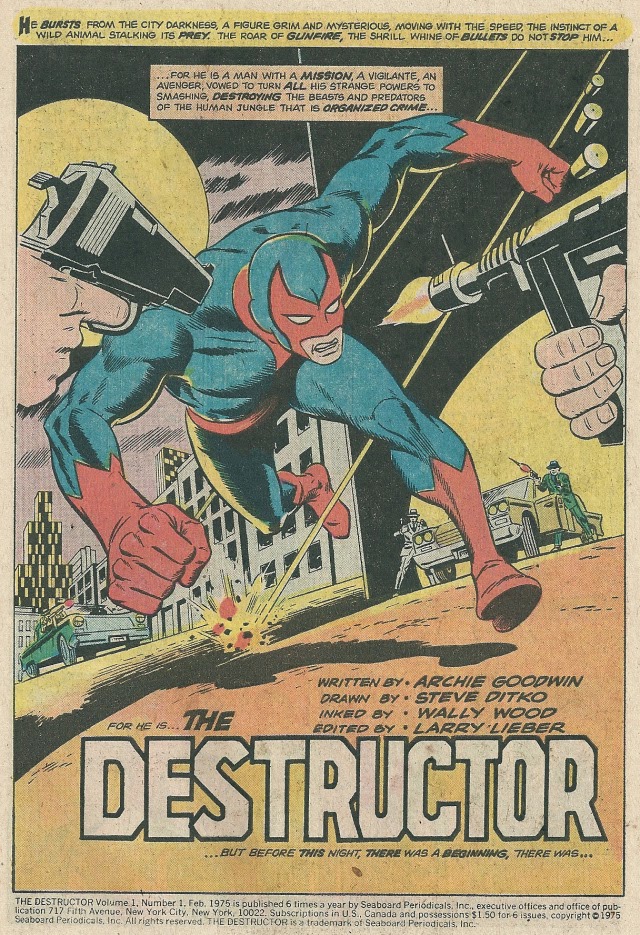 The first issue introduces us to Jay Hunter, a young man who works as a gopher and minor functionary for mobster Max Raven. Think of it like young Henry Hill, in Goodfellas. He's got ambition and has seen a lot. Unfortunately, he doesn't have the mentor that Hill had. Instead, he is considered a liability, after seeing the mobsters working over a disloyal subordinate, and Raven decides to play it safe and sends one of his men to eliminate Hunter. Meanwhile, Hunter is visiting his father, a scientist who has developed a formula that can heighten the senses and physical abilities. he can't find backing for it and wants his sone to play at being a costumed hero, to promote the idea. the son mocks the father and instead seeks an easy life of fast, dirty money. however, fate deals a hand as Raven's hood bursts in, guns blazing. Father protects the son, though he is hit, as well. The dying man pous the formula into his son's mouth, which saves his life. he tells him, with his dying breath, that there is a secret closet, in the lab. When the authorities come, they are stunned to find the boy alive. He is tormented by what occurred, dreaming of the events and the words of his father... 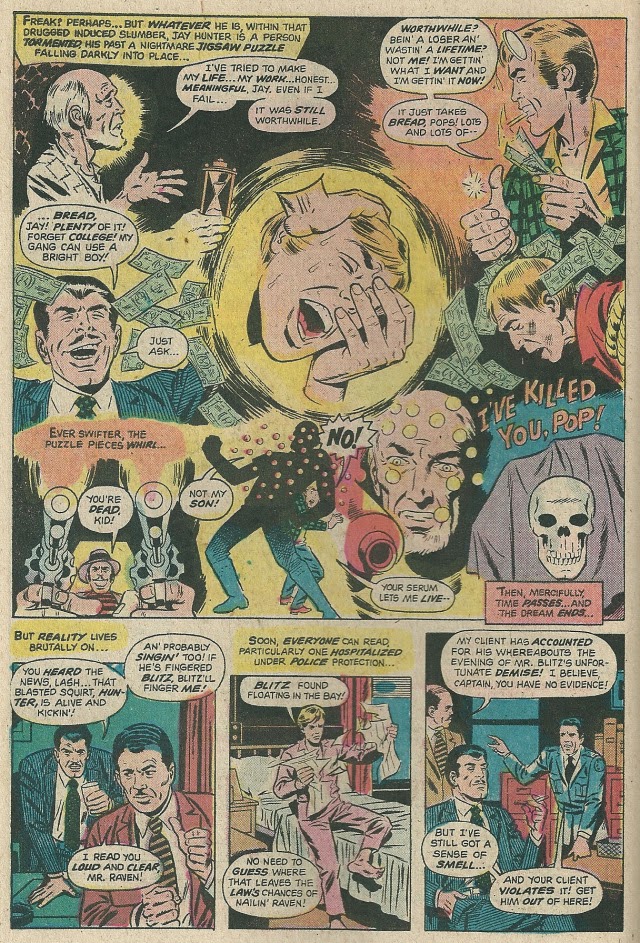 Raven has put a hit on his own hitman, after failing to kill Hunter. Hunter decides to hide out, but finds his school friends less than helpful, after a previous career as a bully and con artist. he's on his own. He remember's his father's dying words and checks out the lab, finding the hidden closet. He finds a costume in there. He also discovers that his senses and abilities have been increased. He decides to use the costume and his abilities to tear up Raven's mob and starts hitting his operations. Each strike sows w more chaos and dissent within Raven's territory. Raven is panicking and sends a specialist, Slaymaster, to kill the Destructor. he nearly does the job, until the Destructor figures out how to use his abilities to take out the super-hitman. He confronts Raven; but, is interrupted by Raven's men, who decide to shift their loyalties to a rival faction. This is terrific stuff, in the grand tradition of the pulps of the 30s and the men's adventure pulps that permeated paperback racks of the day, when this was published. In fact, I would hazard a guess that the reason this guy wasn't called The Destroyer, instead of the more cumbersome Destructor, was due to a little series calle The Destroyer, by Richard Sapir and Warren Murphy.  You might know it better by the movie adaptation...  This first issue is filled with the same "blood and thunder" of both the classic pulps and the men's adventure pulps. It's a nice mixture of Archie Goodwin's love of crime fiction and Ditko's philosophy of self-reliance. Hunter has to go it alone. he's also been a complete jerk, who is driven by guilt and remorse, into righting wrongs. The costume and art heavily invoke Spider-Man, with touches of Daredevil (who was quite the Spider-Man clone, in his early days). Ditko provides lively art, mixing in the tumbling and acrobatics that filled Spider-Man and Blue Beetle, while mixing in his nightmare visions. Wally Wood gives it a nice finish and he is really good ovr Ditko's pencils. Issue 2 finds the Destructor heading west, after being duped into going after a regional boss, who is being used as a Judas Goat. Hunter worms his way in, by contriving to save the boss' daughter from a rattlesnake-spooked horse (he caught the snake and released it near the horse). This puts him in the firing line when Death-Grip, a mob assassin, is waiting. he defeats him, while waking up the mobster's daughter to his past. 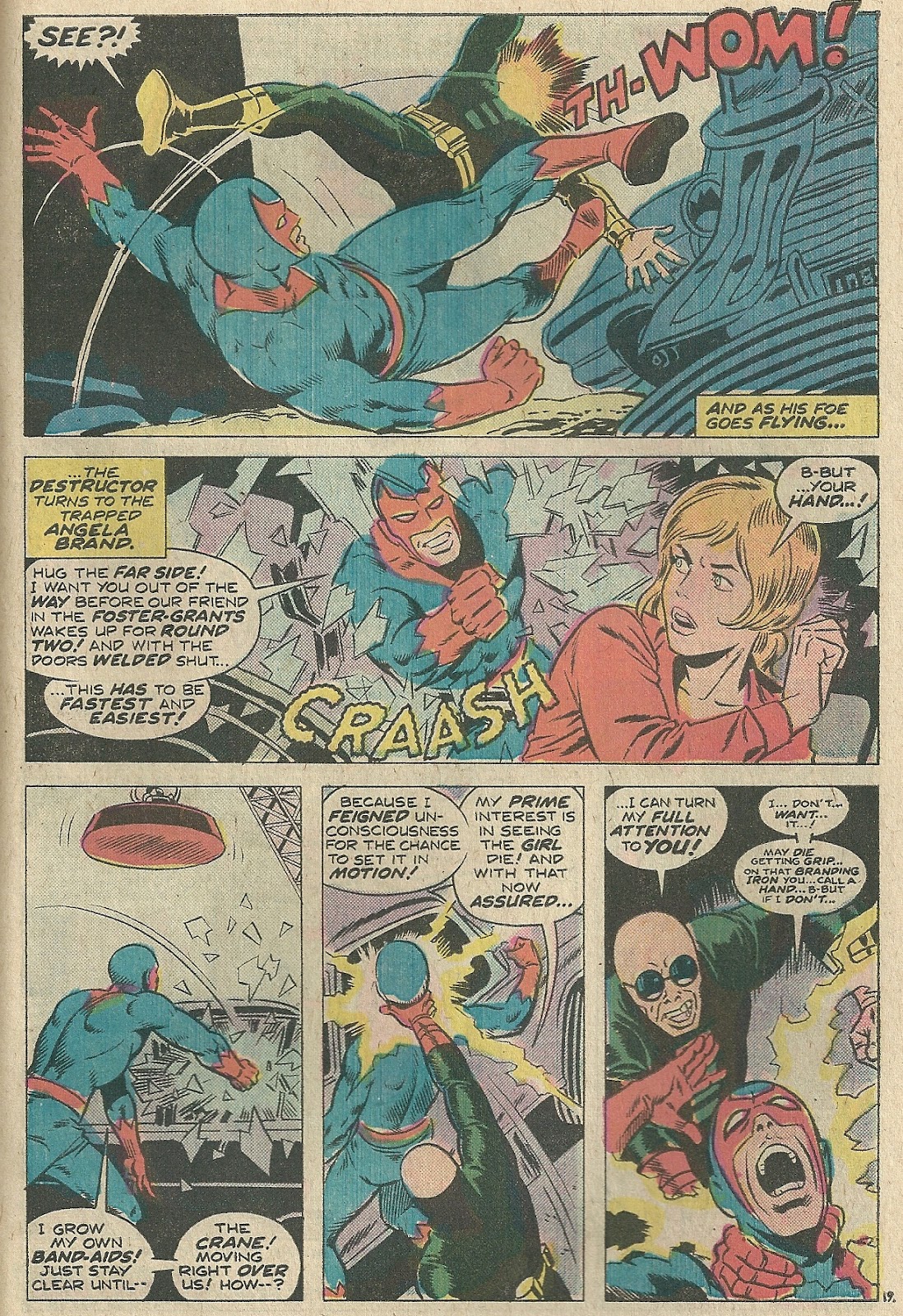 Issue 3 finds a new hit- person sent after the Destructor, The Huntress. no, not Helena Wayne; but, a sort of female Kraven (with slightly less busy threads). She gets closer than any of the previous hitmen; but, doesn't get the job done. 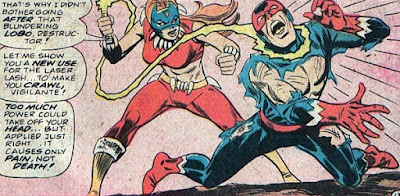 Ditko did the art on his own, this time, though Goodwin is still writing. Then, we get the inevitable revamp. Martin Goodman, seeing the low sales on the first couple of months of comics, demanded everything be made more like Marvel. Editor Jeff Rovin had enough and walked, leaving Larry Lieber to deal with things. Every book got retooled and destructor, which was fairly "Marvel" from the start, was no different. Ditko was still on board; but, Goodwin wasn't. Gerry Conway took over the writing and moved away from the mob and introduced Destructor to an underground society of outcasts. They were people who left behind the turmoil of the outside world; but, were conned by the millionaire who financed the building of their subterranean retreat. he built a nuclear power station to run everything, hoping to market it in the wake of the coming fuel crisis. Unfortunately, the reactor leaked and the residents were irradiated, causing their children to be born as mutants. They attempt to recruit Jay Hunter, who ends up fighting a couple of sides. So, goodbye crime fiction, hello sci-fi, with a bit of a rip-off of the British Avengers ("The Living Dead") and a few other sci-fi properties. 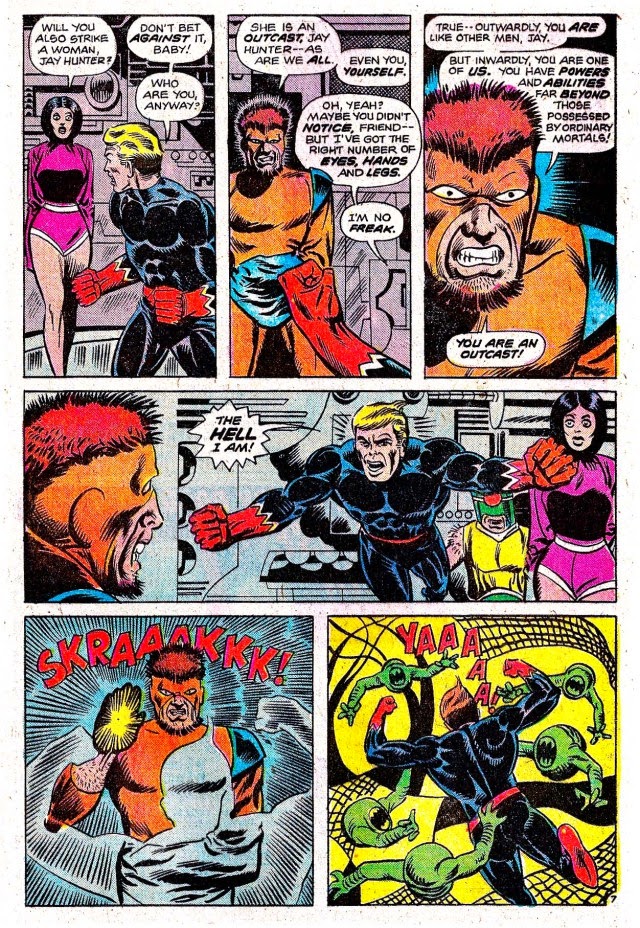 Note the art. Ditko is inked by Al Milgrom and it is a bit clumsy, in spots and doesn't compare to Wally Wood's on the first two issues. That would be it for the Destructor and Atlas, as they succumbed to their bad business practices. Ditko went off to other things. Despite it's success (it was one of 5 series to last past the third issue), it was not part of the attempted Atlas revival, from a few years ago. If you are a Ditko fan, you will enjoy this and if you like hard-boiled crime fiction, with a touch of the superhero, you will also enjoy it. |
|